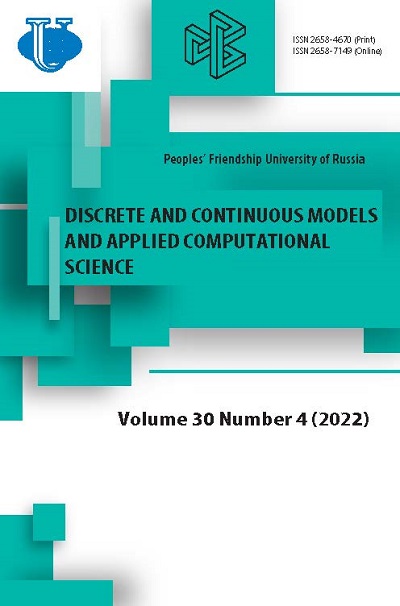Conservative finite difference schemes for dynamical systems
- Authors: Ying Y.1, Lu Z.1
-
Affiliations:
- Kaili University
- Issue: Vol 30, No 4 (2022)
- Pages: 364-373
- Section: Articles
- URL: https://journals.rudn.ru/miph/article/view/33017
- DOI: https://doi.org/10.22363/2658-4670-2022-30-4-364-373
- ID: 33017
Cite item
Full Text
Abstract
The article presents the implementation of one of the approaches to the integration of dynamical systems, which preserves algebraic integrals in the original fdm for Sage system. This approach, which goes back to the paper by del Buono and Mastroserio, makes it possible, based on any two explicit difference schemes, including any two explicit Runge-Kutta schemes, to construct a new numerical algorithm for integrating a dynamical system that preserves the given integral. This approach has been implemented and tested in the original fdm for Sage system. Details and implementation difficulties are discussed. For testing, two Runge-Kutta schemes were taken having the same order, but different Butcher tables, which does not complicate the method due to paralleling. Two examples are considered - a linear oscillator and a Jacobi oscillator with two quadratic integrals. The second example shows that the preservation of one integral of motion does not lead to the conservation of the other. Moreover, this method allows us to propose a practical application of the well-known ambiguity in the definition of Butcher tables.
Full Text
1. Introduction Many dynamical systems have algebraic integrals of motion [1], but standard numerical methods do not allow preserving these integrals exactly on the approximate solution [2]. This means that the approximate solution satisfies such fundamental laws of nature as the law of conservation of energy also approximately, and, in view of the importance of this law itself, this circumstance is always striking. Consider the dynamical systemAbout the authors
Yu Ying
Kaili University
Author for correspondence.
Email: 45384377@qq.com
ORCID iD: 0000-0002-4105-2566
Assistant Professor of Department of Algebra and Geometry
Kaiyuan Road 3, Kaili, 556011, ChinaZhen Lu
Kaili University
Email: 157739594@qq.com
ORCID iD: 0000-0002-7526-9026
Associate Professor, Department of Fine art
Kaiyuan Road 3, Kaili, 556011, ChinaReferences
- A. Goriely, Integrability and Nonintegrability of Dynamical Systems. Singapore; River Edge, NJ: World Scientific, 2001.
- E. Hairer, G. Wanner, and S. P. Nørsett, Solving Ordinary Differential Equations I, Nonstiff Problems, 3rd ed. Springer, 2008. doi: 10.1007/978-3-540-78862-1.
- V. V. Golubev, Vorlesungen über Differentialgleichungen im Komplexen. VEB Deutscher Verlag der Wissenschaften, 1958.
- D. Greenspan. “Completely Conservative and Covariant Numerical Methodology for N-Body Problems With Distance-Dependent Potentials. Technical Report no. 285.” (1992), [Online]. Available: http://hdl.handle.net/10106/2267.
- D. Greenspan, “Completely conservative, covariant numerical methodology,” Computers & Mathematics with Applications, vol. 29, no. 4, pp. 37- 43, 1995. doi: 10.1016/0898-1221(94)00236-E.
- D. Greenspan, “Completely conservative, covariant numerical solution of systems of ordinary differential equations with applications,” Rendiconti del Seminario Matematico e Fisico di Milano, vol. 65, pp. 63-87, 1995. doi: 10.1007/BF02925253.
- D. Greenspan, N-Body Problems and Models. World Scientific, 2004.
- Y. Ying, A. Baddour, V. P. Gerdt, M. Malykh, and L. Sevastianov, “On the quadratization of the integrals for the many-body problem,” Mathematics, vol. 9, no. 24, 2021. doi: 10.3390/math9243208.
- A. Baddour and M. Malykh, “On difference schemes for the many-body problem preserving all algebraic integrals,” Phys. Part. Nuclei Lett., vol. 19, pp. 77-80, 2022. doi: 10.1134/S1547477122010022.
- N. Del Buono and C. Mastroserio, “Explicit methods based on a class of four stage fourth order Runge-Kutta methods for preserving quadratic laws,” Journal of Computational and Applied Mathematics, vol. 140, pp. 231-243, 2002.
- M. Calvo, D. Hernández-Abreu, J. I. Montijano, and L. Rández, “On the preservation of invariants by explicit Runge-Kutta methods,” SIAM Journal on Scientific Computing, vol. 28, no. 3, pp. 868-885, 2006.
- Y. Ying, “The symbolic problems associated with Runge-Kutta methods and their solving in Sage,” Discrete and Continuous Models and Applied Computational Science, vol. 27, no. 1, pp. 33-41, 2019. doi: 10.22363/2658-4670-2019-27-1-33-41.
- Y. Ying and M. Malykh, “On the realization of explicit Runge-Kutta schemes preserving quadratic invariants of dynamical systems,” Discrete and Continuous Models and Applied Computational Science, vol. 28, no. 4, pp. 313-331, 2020. doi: 10.22363/2658-4670-2020-28-4-313-331.
- L. González and M. D. Malykh, “On a new package for the numerical solution of ordinary differential equations in Sage,” in Information and telecommunication technologies and mathematical modeling of high-tech systems. Materials of the All-Russian Conference with international participation, In Russian, Moscow: RUDN, 2022.
- A. Baddour and M. Malykh, “Richardson-Kalitkin method in abstract description,” Discrete and Continuous Models and Applied Computational Science, vol. 29, no. 3, pp. 271-284, 2021.
- W. H. Press. “Numerical Recipes Home Page.” (2019), [Online]. Available: http://numerical.recipes.
Supplementary files















